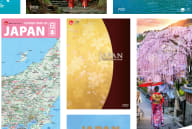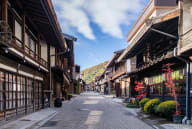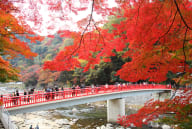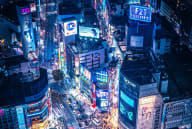
Yamaguchi Seafood splendour, scenic beauty, unforgettable feasts
A Culinary Journey in Yamaguchi
Located in the southwestern part of Japan's main island, Yamaguchi Prefecture offers a blend of historical landmarks, natural beauty, and a diverse culinary tradition. Bordered by the Sea of Japan to the north and the Seto Inland Sea to the south, Yamaguchi has a great climate with mild winters and warm summers, creating favourable conditions for agriculture and marine industries.
Yamaguchi is blessed for its rich agricultural produce, forestry products, and seafood. The prefecture's fertile plains and mountainous terrain produce a variety of crops, including pears, mandarin oranges, and vegetables like burdock, lotus root, and Hanakkori (a Yamaguchi-original hybrid of the Chinese Yu Choy Sum, and broccoli).
Also renowned for its quality seafood, Yamaguchi boasts delicacies such as blowfish, sweet sea bream, and monkfish. Local specialties like Kawara Soba, buckwheat noodles served on a hot tile, and Iwakuni-zushi, a type of pressed sushi, showcase Yamaguchi's culinary diversity and dedication to using fresh, seasonal ingredients.
Surrounded by rich nature, Yamaguchi offers an abundance of delicacies from the sea, rivers, mountains, and villages, fostering a flourishing gourmet culture since ancient times. In Yamaguchi, many dishes considered luxury or high-end items nationwide are commonplace at local restaurants and on the dining tables of ordinary households. At the same time, the simple taste of traditional local cuisine is also passed down, allowing you to experience the lifestyle and warmth of the local people. You can experience the distinct blend of history, culture, and cuisine of Yamaguchi by sampling local specialties, and dining at local eateries while exploring the historic sites like Iwakuni Castle, Kintai Bridge, or Motonosumi-inari Shrine.
Discover the culinary treasures of Yamaguchi and embark on a journey through its vibrant food scene and cultural richness.
Tessa (Pufferfish sashimi)

What it is
Tessa is a delicacy from Yamaguchi, known for its translucent, paper-thin slices. The dish highlights the tender texture and delicate flavour of the puffer fish, which is meticulously prepared by skilled chefs trained in handling this highly poisonous, yet prized ingredient.
History/Origin
Tessa has a long history in Yamaguchi, where it has been enjoyed as a seasonal delicacy for centuries. The puffer fish “Fugu” was banned until 1889 due to its toxicity, prompting it to be called “Teppo” (meaning “gun” in Japanese). Before long diners embraced this slang, coining the term “Tessa”- a portmanteau of “Teppo” and “sashimi”. The prefecture's proximity to the Seto Inland Sea provides an ideal environment for raising and catching high-quality puffer fish, ensuring a fresh and safe dining experience.
Where to Eat
Tessa can be savoured at specialized restaurants and Ryokan (Japanese inns) across Yamaguchi prefecture, particularly in coastal towns like Shimonoseki. These establishments adhere to strict preparation techniques to ensure the safety and exquisite taste of Tessa.
When to Eat
Tessa is best enjoyed during the winter months when puffer fish are in season and at their peak flavour. It is often served as part of a multi-course kaiseki meal or enjoyed on its own, accompanied by sake to complement its delicate taste.
Indulge in the rare and refined flavours of Yamaguchi's Tessa, a testament to the prefecture's culinary expertise and appreciation for exquisite seafood.
Iwakuni-zushi (Iwakuni-style pressed sushi)

What it is (ingredients)
Iwakuni-zushi is a traditional style of pressed sushi from Yamaguchi. It features layers of vinegared rice and various toppings, typically including fresh seafood such as shrimp, fish, green vegetables, lotus root, shiitake mushrooms, egg, and Denbu (flaked fish seasoning). The sushi is pressed into a rectangular or square mould to compact the ingredients, creating a visually appealing and flavourful dish.
History/Origin
Iwakuni-zushi has its roots in the culinary traditions of Iwakuni city in Yamaguchi, where it originated as a portable meal for samurai warriors around in 1600s. Over time, it evolved into a beloved local specialty that highlights Yamaguchi's abundance of seafood and dedication to craftsmanship in sushi-making.
Where to Eat
Iwakuni-zushi can be found at local sushi restaurants and specialty shops throughout Yamaguchi prefecture, particularly in Iwakuni city.
When to Eat
Iwakuni-zushi is enjoyed year-round, offering a delightful taste of Yamaguchi's culinary heritage. It is often served during special occasions, festivals, and as part of celebratory meals, reflecting its cultural significance and popularity among locals and visitors alike.
Experience the artistry and flavours of Yamaguchi with Iwakuni-zushi, a timeless dish that combines tradition, freshness, and meticulous craftsmanship.
Kawara soba (Fried soba noodles on roof tiles)

What it is (ingredients)
Kawara Soba is a unique dish from Yamaguchi, where stir-fried Chasoba noodles (matcha noodles) are served on a hot tile (Kawara) with cooked meat, eggs, and fresh vegetables. The dish typically includes buckwheat noodles infused with matcha, sliced beef, egg garnish, green onions, and lemon, dipped in a savoury sauce made from soy sauce, mirin, and dashi broth.
History/Origin
Kawara soba originated in Yamaguchi, inspired by local traditions of cooking food on roof tiles (Kawara) heated over an open flame. This method imparts a distinct smoky flavour to the dish while ensuring the noodles remain crispy on the outside and tender on the inside.
Where to Eat
Kawara soba is commonly found in specialty restaurants across Yamaguchi prefecture, particularly in the city of Shimonoseki. These establishments offer a unique dining experience where diners can enjoy the sizzle and aroma of their meal cooked on a hot Kawara.
When to Eat
Kawara soba can be enjoyed year-round, but is best enjoyed during colder months when the warmth and aroma of the sizzling tiles complement the extra flavours of the dish. It's a comforting and satisfying meal that showcases the prefecture's culinary ingenuity and love for savoury soba noodles.
Savour the unique traditional taste of Yamaguchi with Kawara Soba, a visually impressive dish with an incredibly unique cooking method.































































